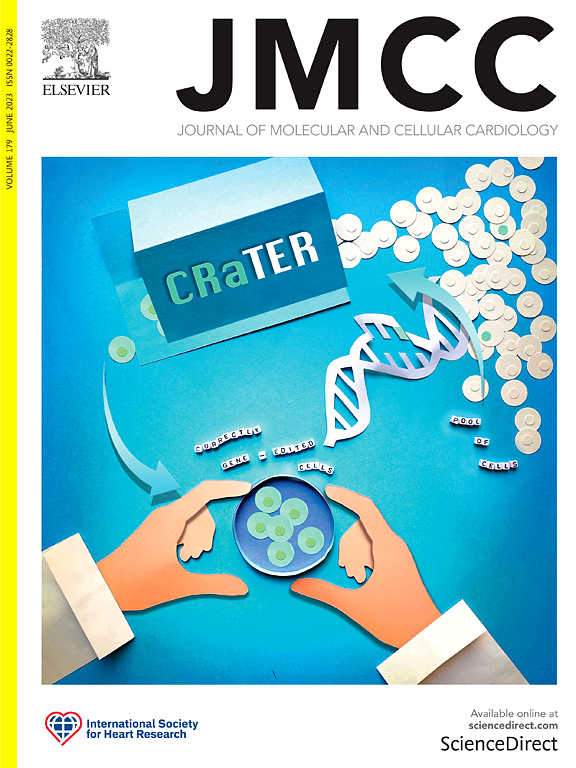钠/葡萄糖共转运蛋白2抑制剂恩格列净以突变特异性的方式抑制长QT 3晚期钠电流。
IF 4.9
2区 医学
Q1 CARDIAC & CARDIOVASCULAR SYSTEMS
引用次数: 0
摘要
背景:钠/葡萄糖共转运蛋白2抑制剂(SGLT2is)如恩格列净已被证明对糖尿病患者或非糖尿病患者具有心脏保护作用。SGLT2is已被证明有选择性地抑制心脏钠电流的晚期成分(晚期INa)。晚期INa的诱导是先天性长QT综合征3型(LQT3)编码Nav1.5的SCN5A基因功能获得性突变的病理生理学的主要机制。我们研究了恩格列净对位于通道不同区域的13个已知LQT3突变的晚期INa的影响。方法:采用全细胞膜片钳技术研究依帕列净对不同LQT3突变的重组表达Nav1.5通道晚期INa的影响。利用人Nav1.5的分子模型和人心室肌细胞的数学模型进行模拟,将实验结果推断为兴奋-收缩耦合。结果:恩格列净选择性抑制Nav1.5失活门区LQT3突变的晚期INa,不影响峰值电流或通道动力学。相比之下,恩格列净抑制了S4电压感应区突变的峰值和晚期INa,改变了通道门控,减缓了失活后的恢复。依帕列净对假定的依帕列净结合区突变的通道的晚期/峰值INa或通道动力学没有影响。模拟结果预测,恩格列净可能对失活门区LQT3突变具有理想的治疗效果。结论:恩帕列净选择性抑制晚期INa,不影响通道动力学,在LQT3失活门区突变。因此,恩帕列净可能是一种有希望的精准医疗方法,用于特定LQT3突变的患者。本文章由计算机程序翻译,如有差异,请以英文原文为准。

The sodium/glucose cotransporter 2 inhibitor Empagliflozin inhibits long QT 3 late sodium currents in a mutation specific manner
Background
Sodium/glucose cotransporter 2 inhibitors (SGLT2is) like empagliflozin have demonstrated cardioprotective effects in patients with or without diabetes. SGLT2is have been shown to selectively inhibit the late component of cardiac sodium current (late INa). Induction of late INa is the primary mechanism in the pathophysiology of congenital long QT syndrome type 3 (LQT3) gain-of-function mutations in the SCN5A gene encoding Nav1.5. We investigated empagliflozin's effect on late INa in thirteen known LQT3 mutations located in distinct regions of the channel.
Methods
The whole-cell patch-clamp technique was used to investigate the effect of empagliflozin on late INa in recombinantly expressed Nav1.5 channels containing different LQT3 mutations. Molecular modeling of human Nav1.5 and simulations in a mathematical model of human ventricular myocytes were used to extrapolate our experimental results to excitation-contraction coupling.
Results
Empagliflozin selectively inhibited late INa in LQT3 mutations in the inactivation gate region of Nav1.5, without affecting peak current or channel kinetics. In contrast, empagliflozin inhibited both peak and late INa in mutations in the S4 voltage-sensing regions, altered channel gating, and slowed recovery from inactivation. Empagliflozin had no effect on late/peak INa or channel kinetics in channels with mutations in the putative empagliflozin binding region. Simulation results predict that empagliflozin may have a desirable therapeutic effect in LQT3 mutations in the inactivation gate region.
Conclusions
Empagliflozin selectively inhibits late INa, without affecting channel kinetics, in LQT3 mutations in the inactivation gate region. Empagliflozin may thus be a promising precision medicine approach for patients with specific LQT3 mutations.
求助全文
通过发布文献求助,成功后即可免费获取论文全文。
去求助
来源期刊
CiteScore
10.70
自引率
0.00%
发文量
171
审稿时长
42 days
期刊介绍:
The Journal of Molecular and Cellular Cardiology publishes work advancing knowledge of the mechanisms responsible for both normal and diseased cardiovascular function. To this end papers are published in all relevant areas. These include (but are not limited to): structural biology; genetics; proteomics; morphology; stem cells; molecular biology; metabolism; biophysics; bioengineering; computational modeling and systems analysis; electrophysiology; pharmacology and physiology. Papers are encouraged with both basic and translational approaches. The journal is directed not only to basic scientists but also to clinical cardiologists who wish to follow the rapidly advancing frontiers of basic knowledge of the heart and circulation.

 求助内容:
求助内容: 应助结果提醒方式:
应助结果提醒方式:


